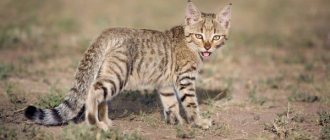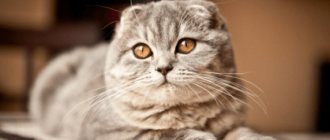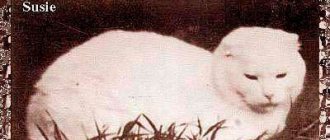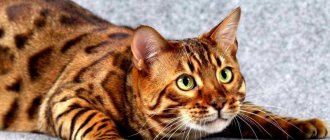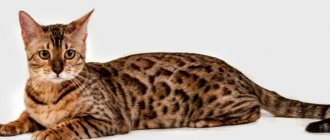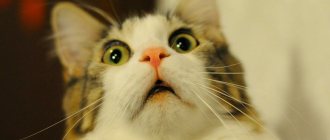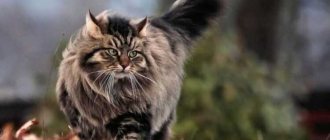Every second home has a cat or male cat, they are loved and cherished. These animals are bought by parents for their children, as well as by single people to stay at home in a cheerful company. How did these animals become so accustomed to people and become so close to us? How did they go through this long process of domestication and become true friends for us?
When did we become friends?
One would think that archaeological evidence would make it easy to understand when cats were domesticated, but wild cats and domesticated cats have remarkably similar skeletons, complicating research. On the island of Cyprus in 1983, archaeologists discovered the jawbone of a cat that was about 8,000 years old. Since it seemed unlikely that humans would have brought wild cats to the island not yet accustomed to humans, the discovery suggests that domestication occurred even earlier.
In 2004, the discovery of an even more ancient site in Cyprus, in which a cat was deliberately buried with a person, made it even more certain that the island's ancient cats were domesticated earlier, pushing domestication back another 1,500 years.
Beginning of domestication
“Our genetic data, our archaeological data and our geology all tell us that cats were probably domesticated more than 8,000 to 10,000 years ago,” Lyons explains.
It was during this period that people first began mass farming in parts of the Middle East, the Indus River Valley region of Pakistan, and the Yellow River Valley region of China. Based on available evidence, scientists and historians theorize that when farmers began growing grain, they attracted rodents, which in turn lured wild cats from their habitats into human civilizations.
"When cats came to the villages, people wanted to keep them because the cats were killing rodents," explains David Grimm, associate news editor at Science magazine and author of Citizen Canine: Our Evolving Relationship with Cats and Dogs. By killing their prey, cats provided crop protection and food storage in these early agricultural communities.
Because these early human-cat relationships were mutually beneficial, cats are often said to have "domesticated themselves," that is, they voluntarily began to live among humans and adopted behaviors that would allow them to continue their attractive new lifestyle. “[These feral cats] not only had mice and rats to hunt, but if they were friendlier, they would also potentially get table scraps and maybe even protection from people,” Grimm says. “So they really should have been a lot more submissive than their wild counterparts.”
© shutterstock
Scientific research
The process of domestication may have begun about 10,000 years ago, when humans settled in the Fertile Crescent, an arched region that includes the eastern shore of the Mediterranean Sea and the land around the Tigris and Euphrates rivers. People stored grain there - the main source of food, which is also loved by rodents, which in turn attracted wild cats. Over time, these wild cats adapted to this artificial environment and got used to people and completely stopped being afraid of them.
Cats were clearly tame around 3,500 years ago in Egypt, where paintings often placed them under chairs. This shows that by that time “the cat had reached the house.” At that time, this animal was a symbol of fertility, since on the frescoes of the ancient Egyptians the cat was depicted under a woman’s chair when the family dreamed of replenishment.
Interesting facts about the process of domesticating cats
- Genetic analysis was carried out on 30 ancient remains and 209 cats from three continents;
- In Egypt, cats began to live at temples and were adored by the clergy, since it was there that the main grain reserves were stored. In the Middle East, gentle predators were also highly valued because they protected manuscripts;
- The remains of 5,300-year-old cats have been found in China. This time is considered the second period of domestication. The researchers found that the bones belonged to a Bengal cat, which at that time was in the early stages of domestication. But over time, the descendants of the steppe species nevertheless supplanted the Bengal ones, since they were more sociable and obedient;
- For a long time, the wild color of cats remained unchanged. Only in the 14th century AD. the stripes began to “blur” into spots. Perhaps there was no need to pay attention to the appearance of the pets; the main thing that was valued was their affectionate nature and hunting skills;
- Wild cats continued to live for a long time next to domesticated cats near human settlements, constantly exchanging genetic material. Therefore, there are no significant changes in our domestic pets compared to wild individuals;
- One of the few changes that happened to cats during the process of domestication was a change in their voice to one that was as pleasant as possible to the human ear;
- “Cats domesticated themselves,” says researcher Carlos Driscoll about how the cat was domesticated.
- Cats were brought to Russian territory by sailors in the pre-Christian era (the cat was considered to accompany the pagan god Veles). The oldest remains date back to the 2nd century AD. Until the end of the Middle Ages, cats were considered a valuable commodity - their price was no less than for an adult healthy ox and was equal to 205 grams of silver. It was forbidden to kill them - this would result in a heavy fine or replacement of the cat with another;
- In Rus', only cats were allowed to enter churches - they saved the bins from the invasion of mice, for which they earned the patronage of the priests. But cats began to live directly in peasant huts only closer to the 18th century.
Ancient DNA of cats
A comprehensive study of cat genes shows that even after felines came into our lives, they remained largely unchanged for thousands of years. In a new comprehensive study of the distribution of domesticated cats, DNA analysis reveals that cats lived for thousands of years alongside humans before being domesticated. During this time, their genes have changed little compared to those of wild cats, with the exception of one recent change: the characteristic stripes and spots on their fur.
According to scientists' research, we can know that the earlier ancestors of modern domestic cats spread from southwest Asia and into Europe as early as 4400 BC. Cats likely began hanging around farming communities in the Fertile Crescent about 8,000 years ago, where they established a mutually beneficial relationship as a rodent patrol for humans.
What is a pet
Almost any animal can be tamed, but this does not mean making it a pet. A necessary condition for domestication is that individuals kept in captivity produce offspring for a sufficiently long period, and that these offspring retain qualities valuable to humans.
Born and raised in captivity, domesticated animals can differ significantly from their wild ancestors. They are usually larger in size, but have less endurance, and in most cases are unable to survive in harsh environmental conditions. Of all the species of domesticated carnivorous mammals, the dog and cat are the most common throughout the world.
Spots and stripes on fur
Wild and domestic cats had no significant differences in their genetic structure, and one of the few traits available to differentiate them was their coat markings.
The study sheds light on the late appearance of spotted or tabby coats, which began appearing in domestic solid-colored cats in the Middle Ages. The gene for the striped coat dates back to the Ottoman Empire in Southwest Asia and later became common in Europe and Africa.
However, it was not until the 18th century that markings became common enough to be associated with domestic cats, and in the 19th century, cat fanciers began selecting cats with special traits to create unusual breeds.
Not everyone likes cats
The history of cats contains several examples of "cool" attitudes, especially in the Middle Ages. Although their outstanding hunting skills made them popular animals, some were wary of their unerring and silent attack on prey. Some peoples even declared cats to be “devilish” animals. And the impossibility of complete domestication also, of course, played against them.
This wary attitude towards furry creatures continued during the era of witch hunts in America - not the best time to be born a cat! For example, black cats were unfairly considered vicious creatures that help their owners in dark affairs. Unfortunately, this superstition still exists, but more and more people are convinced that black cats are no worse than their relatives of other colors. Fortunately, even in those dark times, not everyone hated these graceful animals. As previously noted, farmers and villagers appreciated their good work in hunting mice, which kept the barns stocked. And in monasteries they were kept as pets.
In fact, according to the BBC, most of the legendary animals lived in medieval England. A young man named Richard (Dick) Whittington came to London looking for work. He bought a cat to get rid of mice in his attic room. One day, a wealthy merchant for whom Whittington worked invited his servants to earn extra money by sending some goods for sale on a ship sailing to overseas countries. Whittington had nothing to give except a cat. Fortunately for him, she caught all the rats on the ship, and when the ship landed on the shores of an overseas country, her king bought Whittington’s cat for a lot of money. Despite the fact that the story about Dick Whittington has no confirmation, this cat became the most famous in England.
Bible version
Many admirers of affectionate pets know the biblical legend about the appearance of cats on earth on Noah's ark. When the ship Noah built was saving animals from the Flood, rodents appeared on board, which began to pose a real threat to the well-being of the rescued inhabitants of the ark.
According to myth, a cat and a cat emerged from the nostrils of a lion when Noah stroked the king of beasts. Thus, the ancestors of modern cats saved humanity and all animals from the invasion of rodents on the ship. We recommend reading about how cats see. You will learn about the characteristics of cat vision, vision in the dark, the ability to see into the distance and whether cats see colors or are they color blind?
And here is more about the reasons why cats purr.
[custom_ads_shortcode2]
From street hunters to indoor fur babies
“It wasn’t until the 1700s or 1800s that cats became popular again on a large scale,” explains Grimm. But from that moment on, the path to the “domestic cat” as we know it was still a long one. While cats were cared for as pets in the 19th and early 20th centuries, "most cats being pets are actually very recent," he says. "And that's because cat litter wasn't invented until 1940."
Grimm notes that as cats became closer to people, their legal status also began to change. “About 100 years ago, cats and dogs were so legally worthless that they weren’t even considered property,” he says. Not only are they now legally protected as property, but they also receive additional protections under anti-cruelty and disaster evacuation laws first put in place after Hurricane Katrina.
The 20th century was a period of incredible change for domestic cats. "This transition from them being outside animals to coming into a person's home is a major turning point in them being considered not just animals or pets, but becoming members of the family," Grimm says.
